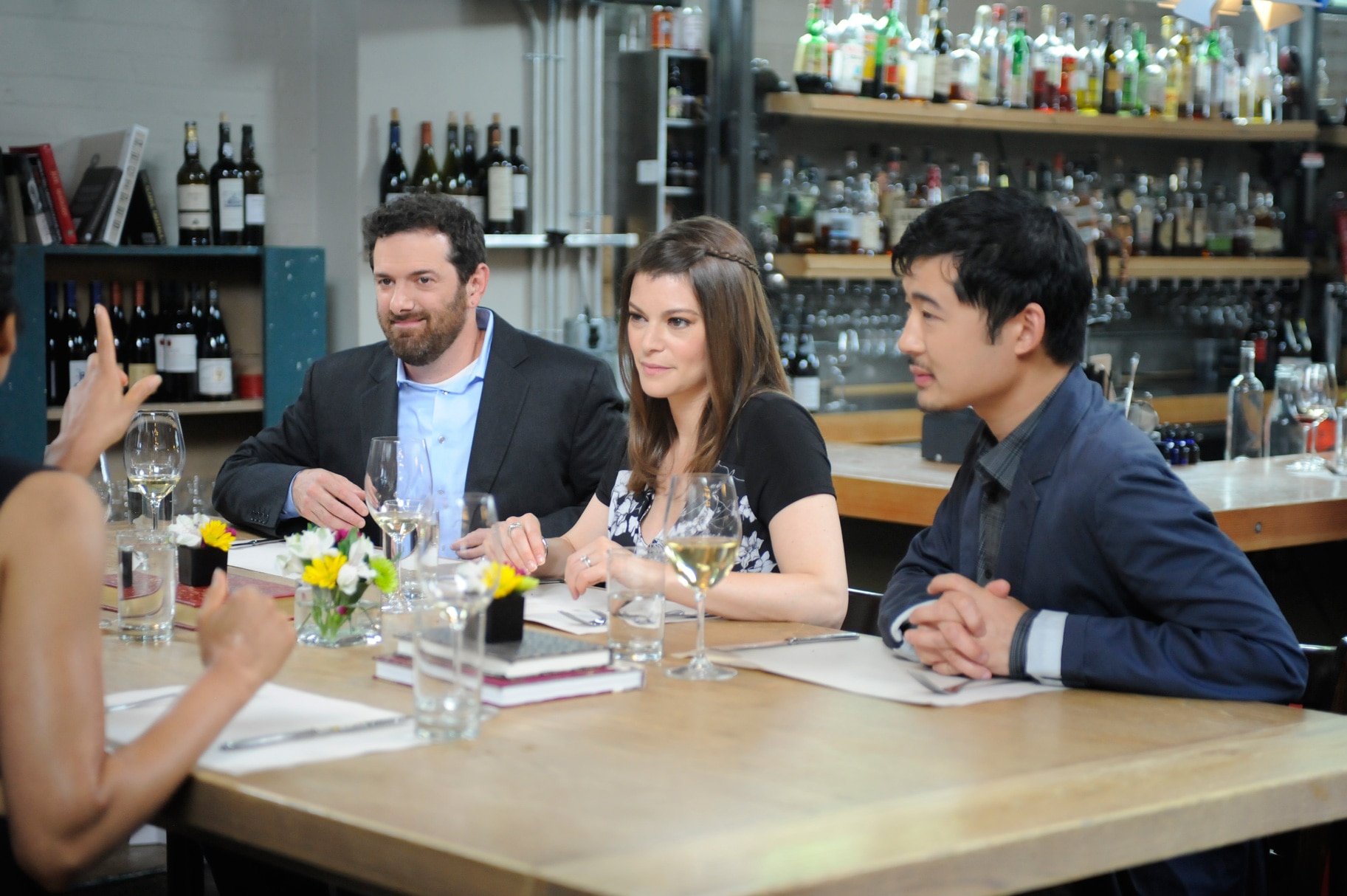Gail Has No Problem With Blood
But she did have some problems with Katsuji's ode to Stephen King.

Bravotv.com: Interesting challenge this week with the chefs taking on some iconic literary works.
Gail Simmons: Obviously, there is a lot of great literature that comes from New England. What I liked most about the challenge was how different all the authors were. I also loved that it forced the chefs to do something a little cerebral and not as literal. It forced them to get out of their own heads, get out of the kitchen, to take inspiration from something completely outside of the food world, which I think is important.
Overall, the food was excellent. We’re at the point of competition when there are six incredible chefs left and not a weak link among them. We started with 16, so this is when everything turns. It gets super challenging, and the chefs really have to push themselves to prove their worth. We start to nitpick because the food gets really good. This is my favorite part in the competition because we eat really well, and our job gets more challenging. It's not easy to sift out the weaker dishes from the stronger dishes any more.
This is my favorite part in the competition because we eat really well, and our job gets more challenging.”
I loved how so many of the chefs took inspiration in such an inspiring and innovative way. They really tried to get in the heads of their authors and show us an interpretation of a literary work on the plate. Some were more successful than others for sure, both in the translations as well as in the flavors of their food. At the end of the day, it could be the most beautiful plate of food interpreted in the most magical way, but if it doesn’t taste good and it doesn’t come together when you eat it, then it's not worth its weight.
All the food tasted absolutely delicious that day. There was nothing that didn't work in terms of the dishes in and of themselves. There were no major mistakes. There was slight overcooking on Gregory's meat, slight thickness in Katsuji's sauce. There were certainly a few people we thought needed to work on their interpretation though.
I do remember that if George hadn't had had immunity, he might have very well gone home that night. He did a beautiful fish dish for Dr. Seuss' One Fish, Two Fish, Red Fish, Blue Fish, but it was so fussy and formal. The only thing that it really had to do with Dr. Seuss was that there were red peppers, blue potatoes, and fish. If you’re going to show me one of Dr. Seuss' greatest works, show us an absurd, witty, upside-down, topsy-turvy world on a plate. It was a chance for him to really reach, to branch out into something crazy and whimsical and silly and fun. His fish was none of those things. It was lovely, but I felt like I had to eat it in a quiet room all alone, which is not what Dr. Seuss would have wanted. But he had immunity so that’s that.
Gregory's explanation of The Raven was an interesting one. I liked that he used the Cornish hens. The food all tasted absolutely excellent. The crispy nori that he put with it tied things together well -- a little sea, a little earthy flavor with the beets. It was a well thought out dish on its own, but he didn't dig deep enough into his interpretation. Just having a small piece of chicken doesn't really do it for me to signify the depth of the story and the importance of the raven as a symbol in Edgar Allan Poe's work. And Chef Tony Maws piece of beef was clearly overcooked. So, as much as it was a pretty plate and a delicious plate to eat, we all wanted it to say more. It seemed like a superficial interpretation. Do something with the raven! Show us something stark, something dark -- not just a little square of grilled hen beside a piece of steak.
Melissa, Doug, and Mei all did a great job. Melissa’s Nathaniel Hawthorne -inspired halibut was cooked absolutely perfectly. This lovely mushroom broth showed that she spent a lot of effort and time on her vegetables, which she always does. The last couple of challenges she served us light, beautiful plates, but we wanted something with more depth. We wanted something that does more than just shows us that she knows how to cut and roast vegetables. Here, that skill was perfectly situated in balance with the seared halibut. Her vegetables were placed in such a beautiful little garden. The charred corn and mushroom broth took us from a light springy dish into something a little deeper and richer, just enough that we understood what she was trying to say. This was the best effort I've seen from Melissa in several challenges. I was really impressed by the beauty and the simplicity of her food. I think it really spoke to her author and her literary work, and the agrarian life in the story she was presenting.
You could tell that Dougie worked really hard to coax flavor out of his carrots, and cumin, orange, and radish, all complimented each other so peacefully in his "Sunshine in a Cup." It came to the table and really was a ray of sunshine. It was a long day on set for us, and at the end of it getting this gorgeous bowl of simple but gracefully made carrot soup showed how thoughtful he was. There was so much flavor to it. He literally poured his heart into this soup and that's exactly what Emily Dickinson would have done.
But Mei was our winner! I think this was an example of a challenge executed perfectly. They all made great dishes, but hers was just one step above the rest. Her dish was so well-conceived: All these immaculately roasted vegetables, with a pile of snow on top to signify winter on Walden Pond, for Henry David Thoreau's iconic work. The snow technique itself can feel like a gimmick, but in this case it wasn't at all. It had so much flavor. It was Tom Kha snow! It tasted of lemongrass and fish sauce and so it gave an otherwise simple dish this incredible intensity. It woke you right up and it made you take notice of the gorgeous vegetables she cooked, which I think is so much the point of Walden, understanding the rhythm of nature, the seasons and the time that Henry David Thoreau spent observing them in solitude. This dish was one of the best I'd eaten all season long.
Sadly Katsuji's Stephen King dish, while full of great ideas, didn't come together in the way that we hoped. We liked that it was messy. We had no problem with his display of "blood." I liked the idea that he did a short rib as the mother and a piece of veal as the child for Carrie. The white beans and chorizo, the ham -- all these flavors go together well enough. But his beet puree was very thick and clumpy, it didn't quite have the texture we wanted to compliment the other components, and to symbolize the pig's blood in the story. Not that he had to be so literal with this, because I wanted them to be abstract and get in the mind of the authors that they were representing, but the fact that he didn't use pig in some way here seemed to miss the mark. He used ham and chorizo but, pig's blood -- there's so much you can do there! It's such an iconic moment in storytelling, when Carrie had pig's blood poured over her. I liked that he used hot sauce as her rage, but again, it all just needed to be a little more cohesive. It felt a bit scattered -- and not in the way that Carrie would have felt scattered. In the way that his idea didn’t coalesce. Bottom line: we wanted the sum to be more than its parts. It didn't add up to a cohesive dish.

Katsuji is such a bright charismatic guy. He has so many great ideas. He has great personality and he's a talented chef. He's irresistible! And he's got Last Chance Kitchen to try and fight his way back.



